
The crisis of Sikh identity was once described to me in very simple terms; most Sikh males no longer want to look like Sardars and most Sikh girls don’t want to marry Sardars. In fact, I distinctly remember several Sikh guys that I went to school cutting their hair for the simple reason of “getting girls”.
Over the past few years, we’ve seen efforts on many fronts to confront this trend, including beauty pageants (Mr. Singh International), Sikh models (Sunny Singh Caberwal of Kenneth Cole and now GQ fame). Now, in a twist on the standard Sikh dharmak or religious song, Taranmpreet has released a track called “Teri Meri Bas: Sat Sri Akal”.

Last year I commented on the UK government spending over £100,000 to (unsuccessfully) figure out how to create appropriate gear for Sikhs recruited into their anti-terror corps. It also wasted a lot of time for a Sikh officer who had been recruited to serve in the corps and then kept in limbo without assignment for over a year.
Well, someone somewhere got the memo. The still new BSPA is working with scientists to design and provide a Kevlar turban for its 2,000+ Sikh police officers, explaining that currently there is no other safe and religiously-appropriate option. The failure to provide this gear directly impacts the employment options and pathways of British Sikhs who serve as police:
Sikh officers have been prohibited from becoming firearms officers because our religion does not allow us to remove the turban…
There has been some research done into producing a ballistic material for turbans and we would like to follow any opportunity where we could manufacture a ballistic product – made out of something like Kevlar – that would ensure a certain degree of protection so Sikh police officers could take part in these roles.
If these turbans are actually useable and wearable, they could open professional options for Sikhs across a swathe of high risk “law and order” positions (and no doubt, the military). On the other hand, a Kevlar turban sounds terribly uncomfortable, and also seems like a somewhat strange alteration of the turban itself. Maybe I am having a hard time wrapping my head around the concept, but I’m not entirely sure how a Kevlar turban could be designed to be both religiously appropriate and, well, a solid hunk of material.
![]() In all honesty, I have grown tired of bhangra. Gone are my days of competing; gone are my days of organizing; gone are my days of even caring.
In all honesty, I have grown tired of bhangra. Gone are my days of competing; gone are my days of organizing; gone are my days of even caring.
Still sometimes there are things that are newsworthy and call for praise and attention. This is one such story.
The Pioneer Bhangra competition, hosted by CSU East Bay’s Associated Students Association, had originally scheduled their competition at Chabot College Performing Arts Center in Hayward on June 6, 2009. The date should immediately ring alarm bells. It was to fall on the day of the 25th year of commemoration of Operation Bluestar (the Third Sikh Ghallughara) in 1984.
If you’re in the DC area on Friday and are free in the afternoon, head over to the Library of Congress at 1:00 pm. Nikky Guninder Kaur Singh, author of “The Feminine Principle in the Sikh Vision” among other works, will be speaking in the  Mary Pickford Theatre on the 3rd floor of the Madison Building.
Mary Pickford Theatre on the 3rd floor of the Madison Building.
When: May 8, 1:00 pm-2:00 pm
Where: Mary Pickford Theater, 3rd Floor, James Madison Building,Library of Congress
101 Independence Ave., SE, Washington, DC 20540
(Metro stop: Capitol South on the Blue/Orange Line)
What: “The Feminine Principle in the Sikh Vision”
by Dr. Nikky Guninder Kaur Singh, Crawford Family Professor of Religious Studies at Colby College
Click on flyer to see full-size.
Good Morning.
I will be taking care of all your problems today. So sit back, relax, and enjoy the rest of your day!
-God
This is what the sign on the wall read at the Salvation Army on the North side of Chicago. Prior to volunteering there, I only knew stereotypes of the homeless and hungry…just what you see on TV. But it didn’t take long for those stereotypes to break down. The people we served meals to were happy, smiling, polite and full of energy. What surprised me most, was their deep sense of spirituality. Not only did I find this in my conversation with folks, but even in their greeting. My standard, “Good morning, how are you?” was often replied with “Blessed” or “In His Grace”, many with bible in hand.
I used to wonder, how could people so hard on their luck, have so much faith? I have seen so many times with family and friends, after they’ve suffered difficult circumstances or loss, God and religion are the first things questioned, i.e. “How could God do this to me?”
 As someone who considers herself honorary Peruvian (it’s a long story) – I was especially proud when I heard about Operation Walk – an organization established by Harpal Singh Khanuja and his wife Maria Khanuja. The non-profit organization is dedicated to providing free knee and hip replacements to underserved people around the world. The concept behind the organization was to perform complicated surgeries on people in developing countries, “where arthritis progresses to its end stages and reconstructing joints becomes technically challenging.” Often times, it is people who are most at need who cannot afford the surgery. A news article discusses Operation Walk’s recent trip to Lima, Peru where they performed 48 surgeries to replace knee and hip joints. Here on TLH we like to highlight examples of seva – this is another important example of what it means to do selfless service,
As someone who considers herself honorary Peruvian (it’s a long story) – I was especially proud when I heard about Operation Walk – an organization established by Harpal Singh Khanuja and his wife Maria Khanuja. The non-profit organization is dedicated to providing free knee and hip replacements to underserved people around the world. The concept behind the organization was to perform complicated surgeries on people in developing countries, “where arthritis progresses to its end stages and reconstructing joints becomes technically challenging.” Often times, it is people who are most at need who cannot afford the surgery. A news article discusses Operation Walk’s recent trip to Lima, Peru where they performed 48 surgeries to replace knee and hip joints. Here on TLH we like to highlight examples of seva – this is another important example of what it means to do selfless service,
“It was very rewarding to do this work for people and not expecting anything in return,” Harpal Singh said. “It’s really their gratitude that you cherish the most.”
The organization’s goal is to replicate the Peru mission to Panjab where the need is also great (some of which can be attributed to the chemical farming of the Green Revolution).
Gatka owes its early development to the Shaster Vidiya, literally meaning knowledge of the arms. This was a warrior curriculum used by the Sikhs for military training. [link]
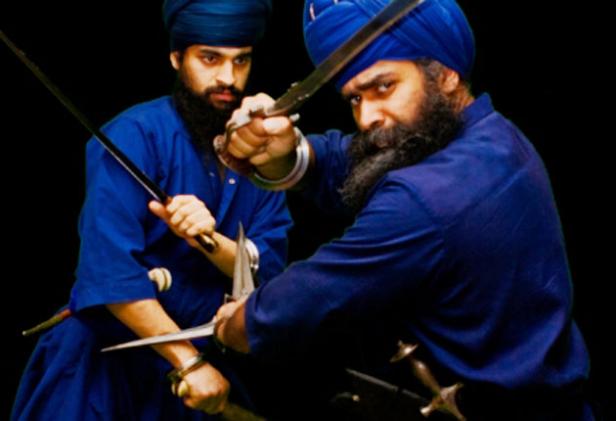 A fascinating article in a UK newspaper highlights the return of Shaster Vidiya – the “world’s original martial art” which was banned by the Raj after the final defeat of the Sikh empire in the mid-19th century. Considered a forgotten art form, Shastar Vidiya was practiced in North India before the emergence of Sikhism. However, it was the Sikhs who were known to have fully mastered this particular fighting style.
A fascinating article in a UK newspaper highlights the return of Shaster Vidiya – the “world’s original martial art” which was banned by the Raj after the final defeat of the Sikh empire in the mid-19th century. Considered a forgotten art form, Shastar Vidiya was practiced in North India before the emergence of Sikhism. However, it was the Sikhs who were known to have fully mastered this particular fighting style.
Now, it seems, young British Sikhs are attempting to revive this lost art form. Their teacher, a controversial figure named Nidar Singh Nihang, has been studying the art of Shastar Vidiya for the past 20 years in hopes of passing it onto the younger generation. Students begin learning how to fight with simple wooden sticks. However, those who show a particular skill and dedication are allowed to practice with the kind of swords that once made the Sikh armies so powerful. The article points out the irony of a British Sikh trying to resurrect shastar vidiya given the history,
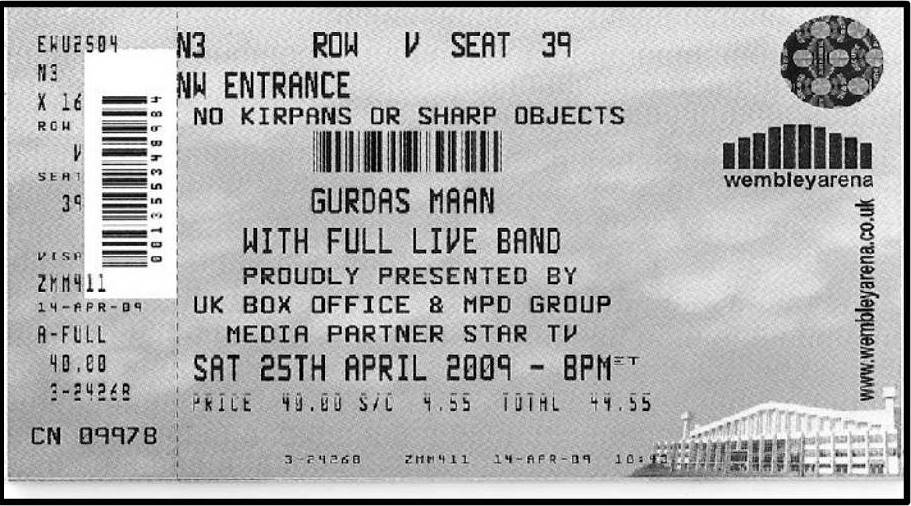
Vaisakhi in the diaspora usually brings two things to those living in cities with large Sikh communities: Nagar Kirtans and Vaisakhi concerts. Unfortunately, if you were an Amritdhari Sikh in London this year and you wanted to partake in both, you would have been out of luck. Tickets for the recent Gurdas Maan concert held at Wembley Arena had a unique warning printed on them, “NO KIRPANS OR SHARP OBJECTS”.
I won’t dwell too much on the irony of banning kirpans at a Vaisakhi concert, which usually start with the requisite dharmak songs, like Gurdas Maan’s tribute to Guru Gobind Singh and his contributions to Sikhi.
What I wonder is exactly what the organizers must have been thinking in doing this. I suspect the banning of kirpans probably falls under generic security rules banning knives and other weapons. In fact the terms and conditions on their website state that the “possession of any article, which is or may be used as a weapon or missile” is strictly prohibited. Pretty standard fare at all large venues.
 Months ago, my fellow langa(w)r-iter asked a question “On Whose Watch?” when Russian tanks retaliated against Georgian incursions. However, and almost all of us here at TLH, I believe, fall into the trap of having an American filter in terms of the news we discuss and don’t discuss have certainly left out a human rights travesty much closer to South Asia – that of Sri Lanka.
Months ago, my fellow langa(w)r-iter asked a question “On Whose Watch?” when Russian tanks retaliated against Georgian incursions. However, and almost all of us here at TLH, I believe, fall into the trap of having an American filter in terms of the news we discuss and don’t discuss have certainly left out a human rights travesty much closer to South Asia – that of Sri Lanka.
Another Sikh writer, Amardeep of Sepiamutiny, recently wrote about the ongoing humanitarian crisis, but as most in the media, in his subsequent comments, takes a statist approach. I believe that many Sikhs, from their own perspectives on state-violence against non-state actors, take a more even-handed view.
The humanitarian crisis is on epic proportions. A recent article by Gareth Evans, president of the International Crisis Group, writes:
As the Sri Lankan army continues its assault on what is left of the separatist Liberation Tigers of Tamil Eelam (LTTE), tens of thousands of civilians remain trapped inside a shrinking conflict zone, at risk not only from the fighting but from starvation and lack of water and medical attention. Despite the government’s April 27 announcement that the military had been ordered to cease using air attacks, artillery, and other heavy weapons against remaining LTTE-held areas, such attacks have carried on with increased intensity.
The trapped civilians are not the only ones at risk. More than 170,000 who have managed to escape the worst of the fighting remain imprisoned in desperately overcrowded camps and medical centers. Scores are reported to have died after fleeing the conflict zone, and the military has been overwhelmed by the number of civilians flooding into reception areas.
Regardless of one’s opinion of the LTTE and their horrific tactics, I would hardly condone a terrorist state, whose own violence and discriminatory practices led many Tamils into the arms of Prabhakaran and others of the LTTE. The LTTE does/did represent the voice of many Tamils.
 Go to virtually any diasporan Sikh’s house that has an interest in Sikhi and you will find the ubiquitous blue book. On the cover is a dashing picture of Shaheed Jarnail Singh Ji Khalsa Bhindranwale. The title: Fighting For Faith and Nation: Dialogues with Sikh Militants. While too few Sikhs actually complete the book to those that are patient and willing, anthropologist Cynthia Keppley Mahmood explores the world of Sikh militants through their own voices, allowing them to air the very humanity that continues to be denied by a totalitarian state machinery.
Go to virtually any diasporan Sikh’s house that has an interest in Sikhi and you will find the ubiquitous blue book. On the cover is a dashing picture of Shaheed Jarnail Singh Ji Khalsa Bhindranwale. The title: Fighting For Faith and Nation: Dialogues with Sikh Militants. While too few Sikhs actually complete the book to those that are patient and willing, anthropologist Cynthia Keppley Mahmood explores the world of Sikh militants through their own voices, allowing them to air the very humanity that continues to be denied by a totalitarian state machinery.
At a time when even too many Sikh authors and scholars were silent as Dr. Mahmood, herself, laments:
“Sikh Studies,” a traditionally Orientalist field that has consciously steered clear of the topic of conflict in Punjab, even as tens of thousands of Sikhs perished, wants us to look at medieval religious texts while the heart of Sikhism is in flames. If we touch the fire, if then too we burn and say ouch! – then we are shunned. But then again, academia has never done well in perilous times.
The Sikhs found two strong voices who I call our Sikh Bibiyan of the Academy – Joyce Pettigrew and Cynthia Keppley Mahmood. In fact, Sikhs who have never had the fortune to meet them, lovingly refer to them by their first names [as if they are part of our family] – Joyce and Cynthia [contrast this with those involved in “Sikh Studies”, who are only known by their last names “McLeod”, “Oberoi”, etc.] Cynthia’s book is a classic and its place on the bookshelf of every diasporan Sikh is every bit warranted. If it is not on yours, make sure to add it.
While all this is covering the familiar, what inspired her to write and give pen to the voices of Sikh militants is every bit as inspiring as those that she interviewed. In my opinion just as those that inspire by fighting for faith and nation, Cynthia is a fighter, gifted with courage and inspiration.
As part of Sikh Chic’s “1984 and I” series, Cynthia reveals her own personal story for the first time:
In this deeply personal account, I describe for the first time how I was assaulted, beaten and raped by a gang of hired thugs or rogue police in a north central Indian state during fieldwork in 1992. A graphic narrative of this event leads into a brief meditation on the sorts of things readers would typically prefer not to know, and on our compulsion as engaged anthropologists to bring them into the conversation anyway. I conclude with the persisting hope of survivors of violence – like many of our ethnographic interlocutors in arenas of conflict – that healing is possible and that change toward justice can occur. Finally, I write of an anthropology that speaks from a spiritual, political and intellectual paradigm which recognizes that, unspoken or not, values of the heart are as central to our field as those of the mind. [Cynthia Keppley Mahmood, Senior Fellow in Peace Studies, Department of Anthropology, University of Notre Dame, U.S.A.]
I encourage ALL to read her entire piece.
 Earlier this month, worldwide Human Rights organization Amnesty International released a news article on the plight of Sikh Massacre victims of 1984, still awaiting justice after 25 years. This came shortly after the Delhi Court delayed ruling on Jagdish Tytler, due to the CBI’s inability to produce enough evidence against him. Ramesh Gopalakrishnan, Amnesty International’s South Asia Researcher stated:
Earlier this month, worldwide Human Rights organization Amnesty International released a news article on the plight of Sikh Massacre victims of 1984, still awaiting justice after 25 years. This came shortly after the Delhi Court delayed ruling on Jagdish Tytler, due to the CBI’s inability to produce enough evidence against him. Ramesh Gopalakrishnan, Amnesty International’s South Asia Researcher stated:
“The fact that almost 3,000 people can be murdered without anyone being brought to justice is offensive to any notion of justice and should be an embarrassment to the Indian government.”
“For the Indian government to dismiss these cases due to lack of evidence is farcical. The various agencies responsible for carrying out the investigations failed to carry out the most cursory of tasks – including recording eyewitness and survivor statements.”
As troubling as it is to read this, I was pleased to find that Amnesty International had covered it at all. As many of know, AI, as well as other independent human rights groups and initiatives were either banned or prevented from conducting research in India in the late 1980’s and early 1990’s. It seems as though there is hope for an independent investigation on the 1984 anti-Sikh pogroms and perhaps the subsequent disappearances during the counter-insurgency.
Not so fast…in an un-related story, the Tribune reported that Amnesty International has decided to shut down its India operations. The decision is said to have been triggered by continued denial to the Amnesty International Foundation of the FCRA (Foreign Contribution Regulation Act) registration by the Government of India.
Continue Reading »
On TLH we have posted on the importance of Punjabi/Khalsa Schools. I have found that despite many students’ resistance to attend these schools, they plant the seeds for future exploration into Sikhi. At the age of 12 you may think you are too cool for school on Sundays, but at 19-20 or even 30 that experience creates a base for you to delve more deeply into your spiritual identity. Thus, I think it is extremely important that each Sikh community have at least one good Punjabi/Khalsa school. Ideally, I would want each Gurdwara to have one.
However, Punjabi/Khalsa Schools run into problems because in some way or another they become linked with communal politics. Most often this politics infiltrates schools within Gurdwaras. I think a fundamental component of a Gurdwara is a Punjabi/Khalsa School as is a Langar Hall. However, for many Gurdwaras, Punjabi/Khalsa Schools are a last priority. Gurdwara committees will fund new kitchen appliances before making a commitment to continually fund a Punjabi/Khalsa School. Thus, some community members have decided to create Punjabi/Khalsa Schools outside of the Gurdwara in local community-centers. When I hear this, I am both excited and disappointed. Excited that a school has been established; but disappointed that we are showing Sikh youth that we have to step outside of our main institution, the Gurdwara. How are we supposed to socialize our children into a Gurdwara-going culture when our leadership doesn’t support it in action? It’s a Catch 22. I don’t blame community members for creating schools outside of the Gurdwara. Their circumstances are real and, many times, this is their only feasible option. Or is it?
One of the underlying issues to many of the discussions we have here on TLH seems to focus upon whether or not elements of Sikhi are being redefined as we evolve in the communities within which we reside. We often take concepts such as Seva, Sangat and Simran for granted without wondering if they are being fulfilled in their true element. I post on this topic not to argue whether or not what we do is right or wrong – but rather in what forms we see these concepts exist today.
In the midst of this world, do seva, and you shall be given a place of honor in the Court of the Lord. SGGS p26
One example that comes to mind is how gurdwaras and the sangat (I include myself in this sangat) have essentially ‘outsourced’ the kitchen seva. Each time I have visited one of the gurdwaras in my area, I notice that the sangat departs after eating langar, leaving behind a kitchen full of dirty pots and pans. This does not seem to be an issue because many gurdwaras have now hired help to come in and essentially do the seva. I understand the gurdwara’s reason for hiring help (the dishes have to get done) but I wonder how we got to this point. I’m not sure if this is an issue unique to North America or whether it occurs in India and also in the UK, for example. During my last few visits to gurdwaras in India, I was so impressed by the amount of seva that was occuring in the kitchen and was also inspired by the energy that was produced from the sangat working selflessly towards a similar goal.
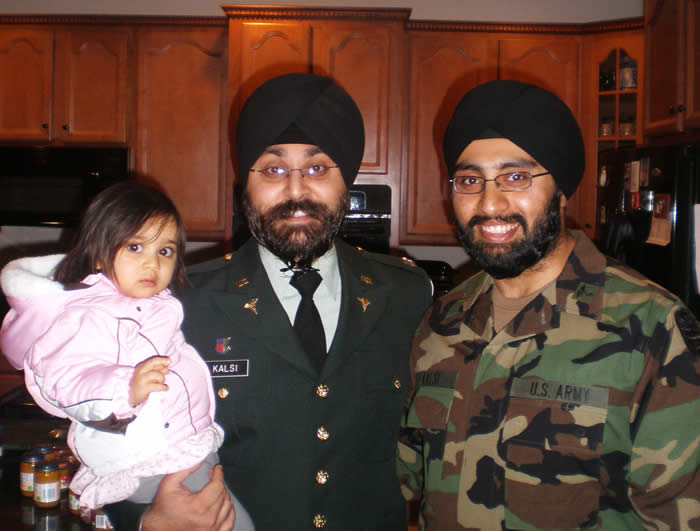
Sikhs Now: Kamaldeep Kalsi (L) and Tejdeep Rattan (R)
Two Sikh recruits in the U.S. Army, Kamaljeet Singh and Tejdeep Singh, were told they would be allowed to continue to wear their turbans as active members of the military. They describe this as being able to wear both their uniforms: that of a Sikh, and of a member of our Armed Forces. Now Army personnel have back-pedaled, claiming a 1981 ban prohibits soldiers from wearing “overt” articles of faith — including the dastar.
Despite a long history of Sikh participation in armed forces worldwide, Steve Levine, a former Army lawyer from 1992-1999, speculates that there are at least two policy reasons for requiring shorn hair: unit cohesion, and the ability to wear military equipment [link]. This seems incongruous given that Sikhs had served on active duty in the Army with full daris and dastars, and were perfectly well-protected, in the past. In light of previous exemptions, lawyers for these Sikhs argue the policy is an undue burden on the free excercise of faith under the Religious Freedom Restoration Act of 1993.
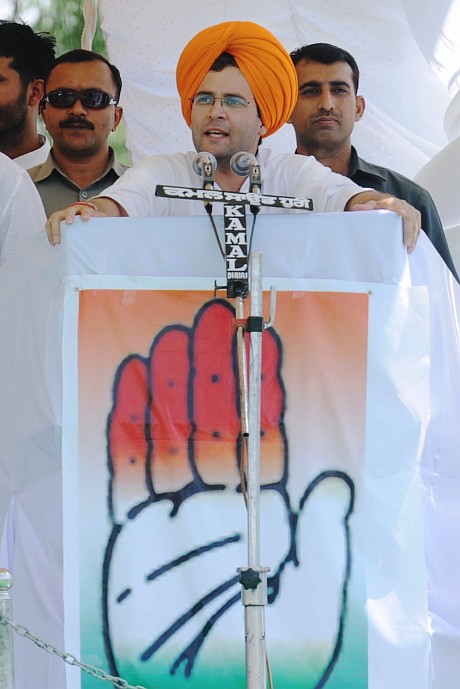 OR HOW NOT TO PULL A SIKH-RELATED PUBLICITY STUNT
OR HOW NOT TO PULL A SIKH-RELATED PUBLICITY STUNT
I will leave the PR-stunt by Congress heir-apparent, Rahul Gandhi, son of Rajiv Gandhi, grandson of Indira Gandhi, and great-grandson of Nehru and his ill-advised (or rather ill-positioned pagri) to speak for itself. A pictures is worth 1000 words and ‘ridiculous’ is one of those that come near the top for this election stop near Takht Damdama Sahib.
On a bit of a serious note, although I hate writing short posts without analysis, I came across a finely-written article about the ‘Shoe-hurling Sardar and Deep-rooted Sikh Grievances‘ published in a Pakistani newspaper that I wanted to bring to our readers’ attention.
I initially cringed when I read stereotypical sentences, such as:
However, Sikhs are known for their forthrightness and carrying a level head in emotionally charged situations is not one of their strengths.
Eventually I got over it and just focused on the substance of the matter. Definitely worth a read.
For my previous coverage, see here and here.
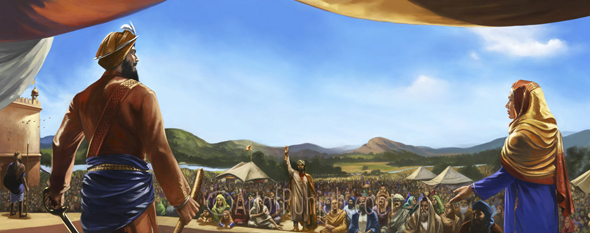
With Vaisakhi upon is, what is it you think of? Perhaps Anandpur Sahib, the city of bliss? Maybe the Panj Piaray, the five beloved ones? Or perhaps it is Guru Gobind Singh Ji’s message of fraternity and equality that resonates with you. Whatever it is that you think of, I wonder if it stirs you or moves you to see the world in a different light – in the light that our Guru hoped for us. On this day, in 1699, our Guru gave us the potential to be born again. Without caste, without discrimination, and without fear.
It is clear that issues of caste and discrimination still play a role in our communities today. However, I came across a promising article in the Guardian which discusses how a small café in India is challenging long-held caste taboos by hiring Dalit women to work within the café as waitresses. Although the Indian constitution banned untouchability sixty years ago, Dalits are still often forbidden, in villages and small towns, from doing anything other than low menial jobs. We all know it is not easy to challenge century-old beliefs, however this café is doing just that. As Sikhs, these issues should matter to us and we should stand up against injustice within any community.
An interesting paper, which I found on the Punjab Research Group site, titled “Dalits and the Emancipatory Sikh Religion” discusses the role Sikhi played in liberating Dalits.
It is beyond doubt that Sikhism emerged as an emancipator for the lowest of the low. Nanak, the first Guru, was clear when he says:
A few months ago, with our first TLH book club, Jodha blogged about Sikhs In Britain. The book was a fascinating insight into how the lives of Sikhs living in England have been shaped over generations. In a similar attempt to historically document the Punjabi Sikh community in the UK, The Southall Story is a project that celebrates a town that has “welcomed new communities throughout the last century, enabling them to excel and influence both the social and political structures of this country.” Through a series of public events, performances, exhibitions and forums, the project aims to educate and inspire people about their heritage.
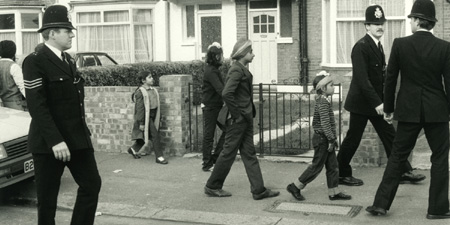
Southall is also a place that has come to be affectionately known as Little India, but for many it is much more than that. Being a port, (Heathrow is a stones throw away), Southall has been a home to such diverse groups as the West Indians, Indians and Pakistanis in the 50’s through to the Ugandan Asians in the 70’s. Most recently, new arrivals include Sikhs from Afghanistan and Somalians.
These settlements invariably have influenced and shaped Southall. Pivotal moments such as the racist murder of teenager Gurdip Singh Chaggar in 1976… meant that as a community issues of race and gender could no longer be avoided. [link]
Well, it seems like the sex ratio in Punjab is not improving despite the number of trees Mrs. Badal is planting and the SGPC’s desire to raise unwanted girl children.
The Tribune reports:
In 2001, the census of India recorded Punjab’s sex ratio at 876 females for 1,000 males, one of the worst in the country. The preliminary findings of a Lucknow-based agency AMS engaged by the government to assess the current situation shows that sex-ratio in many districts of the state has plummeted further.
First, AMS’s study has called out the Punjab government’s bluff in data collection. Apparently, the data collected by Punjab government agencies painted “… an unbelievably rosy picture of the situation”. The Social Security Department and Health Department have reported two different results. These results also do not match those of AMS.
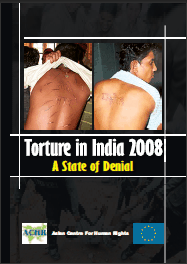 I recently stumbled on a report from the Asian Centre for Human Rights (ACHC), titled Torture in India 2008: A State of Denial. This document claims to be “the first nationwide assessment of the use of torture in India.”
I recently stumbled on a report from the Asian Centre for Human Rights (ACHC), titled Torture in India 2008: A State of Denial. This document claims to be “the first nationwide assessment of the use of torture in India.”
ACHC is a Delhi-based organization focused on protecting human rights throughout Asia, with what appears to be a specific focus on South Asia. I’m not familiar with this organization, so I’d be curious to hear if others can support or disprove their work.
The report focuses on the use of torture by police and security forces from routine arrests to counter-insurgency operations. Although it is clearly a preliminary analysis, it’s findings are quite alarming. The report notes:
The statistics of NHRC imply that in the last five years 7,468 persons at an average of 1,494 persons per year or four persons in a day died in police and prison custody in India. However, these figures represent only a fraction of the actual cases of torture. Cases of torture not resulting in death are not recorded.
Particularly troublesome was the section on custodial torture of women and children.
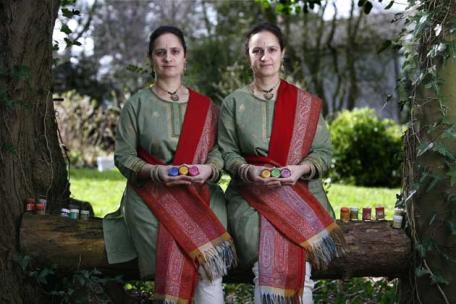 Does the West’s emphasis of the individual subvert community consciousness in the art world? UK-based artists Amrit and Rabindra Singh explain that the primacy of the individual versus other relationships does not resonate with art elites as naturally as it may for others:
Does the West’s emphasis of the individual subvert community consciousness in the art world? UK-based artists Amrit and Rabindra Singh explain that the primacy of the individual versus other relationships does not resonate with art elites as naturally as it may for others:
“Western contemporary art is all about the individual, the inner self,” reflects Amrit… We were constantly being told that to be individual was healthy, that we had to be more different from each other, be influenced by different Western artists from each other, but that didn’t seem valid to us. From the point of view of Sikh, Indian or even Asian philosophy, the community comes first and the individual is second.” [emphasis added]
I thought this article was a fascinating description and reflection on the structural challenges Sikh artists, particularly Sikh women of color artists, face within the art establishment in the U.K.
The twins described their sense of community and of shared experiences when conceptualizing and creating their art. This first barrier — that art that does not conform to the frame of mainstream art teaching — seems obvious, and yet such a subtle feature that it makes it difficult to push around it. This is a fairly distinct difference (individual vs. multiple social awarenesses) of philosophical development between the canon of European/American philosophers and philosophers from the different regions of Asia, but it was fascinating to see how it repeats and excludes through artistic representation. Not only that, it creates a less obvious form of discriminatory thinking in the art academy than the standard, run-of-the-mill racism.
